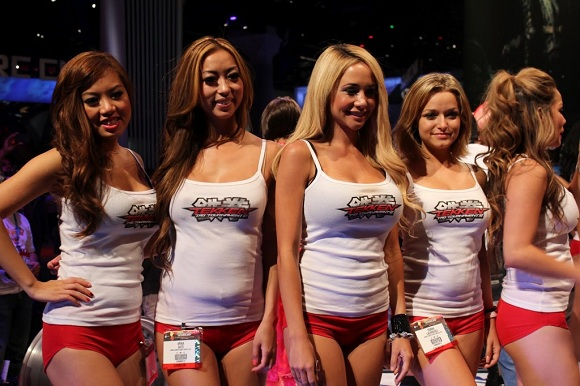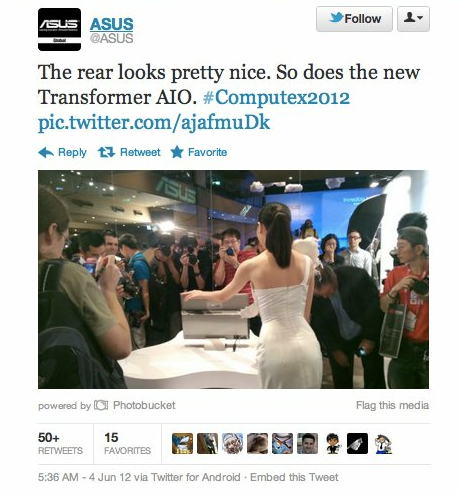
There’s been no shortage of discussion about women and video games this past week.
The conversation’s been driven by the gross response to Anita Sarkeesian’s nearly finished Kickstarter about the unfortunate and exclusionary tropes of female video game characters, and the quickly scrutinized comments from a producer on Tomb Raider about a potential rape scene (a description the studio has walked back) in the new game.
These are all good, uncomfortable conversations to have, but if we're talking about the depiction of women in games at such a serious level, how do we still have E3 booth babes? Other than for easy hits in web galleries, anyway.
The commonly referred to booth babe (also known as a "woman") is hired solely to wear skimpy clothing with a game or company’s logo and take photographs with attendees (who does that, by the way?). Typically, they are not well versed in the product they are hired to represent.
It seemed like a good time to check in with the Entertainment Software Association, who manages E3.
Despite some of the recent heated conversation, there are no plans to shift E3 policies.
"Exhibitors determine for themselves what is the best representation for their companies. Models are welcome if companies would like to have them, but that's an individual exhibitor decision,” said ESA VP of media relations and event management Dan Hewitt in an emailed statement to me yesterday.
Ghost Recon Commander designer Brenda Brathwaite sparked a vocal debate on Twitter over booth babes before she headed to the E3 show floor last Thursday.
“I dread heading off to work at E3 today,” she said. “The show is a constant assault on the female self esteem no matter which direction I look. I am in good shape, yet it is impossible not to compare. I feel uncomfortable. It is as if I walked into a strip club w/o intending to. These are the policies of @e3expo and @RichatESA. I feel uncomfortable in an industry I helped found.”
Her comments found plenty of support, such as Inside Network managing editor AJ Glasser.
@br The worst is when I get so good at seeing right through it that I forget they're actually women underneath the barely-there clothes.
— AJ Glasser (@Joygirl007) June 7, 2012
It’s not a new critique, but it was louder this year, and there seems to be a growing desire for change.
There was also the usual “what’s the big deal?” responses, including 3D Realms co-founder George Broussard.
@br I think you/others take it too seriously. It's not some academic event. It's a glitz show full of spectacle. #serious_business
— George Broussard (@georgeb3dr) June 7, 2012
It’s been a few years, but the ESA policy on booth babes has changed from E3's inception. The last major shift came in 2006, as new penalties, fines and policies were introduced regarding women featured in E3 exhibits.
"What's new in 2006 is an update and clarification of the enforcement policies; as we do from time to time, we have taken steps to ensure that exhibitors are familiar with the policy and how it will be enforced," said E3 show director Mary Dolaher to Reuters at the time.
A violation of the clothing policy would result in, at first, a warning, and then a $5,000 fine. Here’s what the handbook from 2006 said to exhibitors considering booth babes--er, sorry, live models:
"Material, including live models, conduct that is sexually explicit and/or sexually provocative, including but not limited to nudity, partial nudity and bathing suit bottoms, are prohibited on the show floor, all common areas, and at any access points to the show."
Hewitt told me there have been no changes to ESA policy since 2006.
Maybe there should be. Consider this anecdote that didn’t even take place on the show floor itself.
We arrived to our Capcom appointment, I plunked down with Lost Planet 3, and Alex Navarro was ushered over to play Devil May Cry. In a room of kiosks, there were pole dancers. It’s unclear what that has to do with Devil May Cry. The girl hired to skimpily waltz around was sitting on the floor, looking bored. Everyone in the room is focused on playing the game, and Alex wasn't playing Devil May Cry in a see-through bubble. No one on the show floor could see this room. Can someone explain how this helps anyone do their job?
Elsewhere, I refused to play any 3DS games at Nintendo’s booth because the company didn’t have a table with machines, and instead tethered its lineup to attractive women. I let that gimmick slide when Nintendo pulled the same trick at the original 3DS unveiling, but I’ll just wait until those games are out now, thanks.
Nintendo probably thought it was a cute idea. I doubt (and this is my sincere hope) Nintendo meant to undermine the credibility of women at gaming’s biggest show. It's still ignorance. Many of the issues regarding women and E3 aren’t overtly offensive, and can be easily rationalized by those who don’t see a problem.
That’s okay--we should have a debate about it.
And this is all hardly an issue that’s exclusive to games. The same week as E3, the Computex Summit was happening in Taipei, and computer manufacturer ASUS sent out the following tweet:

That tweet has since been deleted and ASUS released an apology, obviously.
I can gripe all I want, but the most effective solution has to come from the ESA itself. Only the ESA can enforce regulations on exhibitors, and let them know this archaic marketing tool needs to go away. If games are growing up, so does the way we go about advertising them in front of, ostensibly, a bunch of professional. This isn’t 1994.
PAX figured this out years ago, even if there have been incidents along the way (i.e. Lollipop Chainsaw at PAX East).
“Our definition of a ‘booth babe’ has been a model (male or female) that has been hired to stand/sit in skimpy clothing to market the product,” said Penny Arcade president of business development in 2010. “If that person knows the product inside and out then it’s less of an issue. A company representative that can interact with attendees in a way that provides value as opposed to ‘hey stare at my body’ is something that we encourage whether or not that representative is physically attractive or not.”
If E3 is supposed to represent the industry’s best, why can’t it figure out how to respect its own attendees?